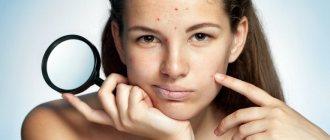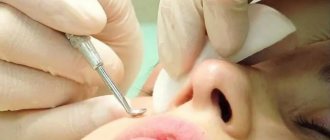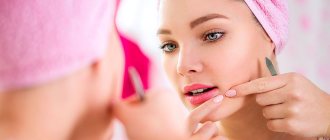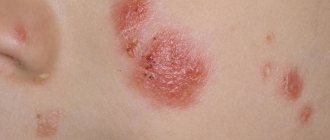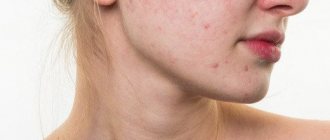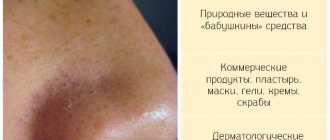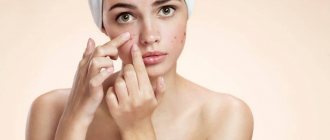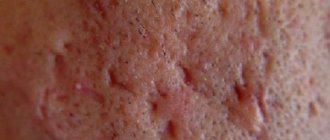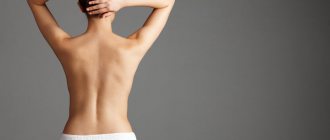Problematic skin causes discomfort not only during adolescence and rampant hormones. Therefore, the path to the ideal is often long and winding. After a stubborn fight against acne, a new period begins, no less complex and even more responsible: skin restoration, removal of acne marks - scars, cicatrices and hyperpigmentation. The MAKEUPSTORE team knows that the result of a hard-fought battle is worth the wait.
Professional ways
Hardware and injection therapy are a more serious and effective method of treating acne marks, but you should be careful here too.
Currently, there are many cosmetologists offering to get rid of scars in several procedures. You shouldn't believe in the possibility of something like this.
A qualified, competent specialist who has experience and work experience will always warn that scar treatment will be lengthy and not always 100% effective.
The sooner a person goes to the clinic, the greater the likelihood that the skin will regain its former beauty.
What the salon can offer
- Mesotherapy. The procedure involves injecting cocktails into the skin, thanks to which it receives the necessary elements for restoration.
- Photothermolysis is a laser skin resurfacing that helps achieve impressive results. The procedure is indicated to combat scars, wrinkles, acne marks and deep pigmentation.
- Ultrasonic cleansing is designed to cleanse the skin of impurities using ultrasound, which is least traumatic for it. During the procedure, dead cells are also removed, micromassage of the deep layers of the epidermis occurs, which has a positive effect on its condition.
- Chemical peeling is the removal of dead particles using special acids.
- Ozone therapy. Treatment is carried out using ozone, which is generated by a special device. Gives an immediate effect.
- Microcurrents. This therapy is a type of physiotherapy. Microcurrent pulses affect cells, helping them recover.
- Mechanical resurfacing is the removal of the top layer of the damaged area of the epidermis using a special apparatus.
- Deep dermabrasion. Another type of peeling, which is carried out by a cosmetologist using abrasive hardware attachments.
- Cryodestruction. Treatment occurs by treating the skin with liquid nitrogen.
- Electrocoagulation is most effective against whiteheads. Carried out using electric current.
- Plasmolifting is an injection of plasma that is enriched with platelets.
- Darsonvalization. Treatment occurs using the Darsonval apparatus. Used as an additional remedy to the main treatment.
- Radiosurgery. Most suitable for the treatment of skin tumors.
A competent cosmetologist will help you choose the appropriate procedure in a particular case, prescribe the required course duration, and warn about contraindications and possible complications.
In the specialist’s office, it is imperative to tell about all diseases, pregnancy or breastfeeding, and allergies.
Such cooperation with a doctor will help solve all skin problems quickly and without further trouble.
How to achieve the best result?
The effect of natural ingredients and some other substances that make up homemade masks (peroxide, for example) requires long-term use, and if certain rules are violated, the effectiveness of cosmetics may decrease:
- You should not be exposed to tanning or excessive UV radiation while whitening your face;
- choose the autumn-winter period for treating post-acne;
- When using store-bought masks, strictly follow the instructions, do not use them on the same day as home remedies;
- for whitening you need to repeat at least 10 procedures, evaluate the result and ALWAYS take a break;
- to eliminate scars, you need to undergo at least 20 procedures, since the skin requires more intense and prolonged exposure;
- You should not distribute cosmetics for scars and scars all over your face;
- It is prohibited to rub the composition into the affected area;
- Before use, the skin is steamed for 7-15 minutes over a bath.
It is better to start treatment after all inflammation has disappeared, because some aggressive substances in the composition or, for example, paraffin, can worsen the healing process of wounds.
Preventing acne spots on the face
To ensure that acne spots no longer become a problem for you, you need to take preventive measures. They consist of the following rules:
- If possible, try not to squeeze pimples. An infection may occur, the inflammation will worsen, and bright red spots will remain.
- When going out into the sun, use sunscreen. Exposure to sunlight can aggravate the condition of age spots.
- Take proper care of your facial skin to prevent the appearance of pimples in general. If necessary, visit a cosmetologist who will help you choose caring cosmetics and advise the procedures that are necessary for you.
The red marks left on the skin after acne breakouts are unpleasant and can be irritating. But getting rid of them is much easier than getting rid of scars. The process will require time and careful attention to caring procedures, but the result will be worth it.
Why do acne scars appear?
- The main reason for the appearance of scars and purple spots on the face is considered to be neglect of hygiene rules when squeezing out ulcers. In most cases, the procedure is carried out incorrectly, as a result of which the root of the tumor remains under the skin. Moreover, if squeezing is done with dirty hands or nails, an infection begins to develop. The affected area increases in size due to the proliferation of bacteria.
- It is not uncommon for deep scars to remain in the skin. They appear when a purulent pimple is squeezed out several times in a row at a certain interval. As a result of such manipulations, all layers of the epidermis are damaged. If regenerating (restorative) ointments and antiseptics are not used, bacteria affect an increasingly larger area.
- The reasons for the appearance of scars include the inexperience of the cosmetologist in the case when acne removal is carried out in a salon. The technician may accidentally introduce an infection without disinfecting the instruments. Also, the technology for getting rid of acne may be chosen incorrectly.
- It is known that acne is considered a serious disease that affects all layers of the epidermis. If the disease continues for 18 days or more, without proper intervention, the area of the rash expands. Scarring of tissue begins after treatment with strong antibiotics and cosmetics.
how to quickly get rid of acne marks
Types of pathology
The consequences of acne are cosmetic defects of the skin and can manifest themselves in the form of:
- pore expansion;
- persistent erythema;
- scars/scars;
- vascular changes (spots);
- dyschromia.
It is important to know your type of post-acne in order to choose an effective treatment method, so let's look at each of them in more detail.
- Enlarged pores appear due to the hyperfunction of the sebaceous glands, which produce a large amount of sebum that accumulates in the ducts, due to which their walls become compacted and the surface layer becomes more keratinized, with the formation of an uneven texture (relief) of the epidermis.
- Persistent erythema appears when there is improper mechanical action on inflamed skin lesions, leading to their injury and the appearance of blue spots, indicating a violation of local blood microcirculation. The aesthetic condition of the epidermis deteriorates, and the resulting defects become especially noticeable during the cold season.
- Scars/scars are formed as a result of a violation of the regenerative function of the skin due to its frequent compression, trauma and hereditary predisposition against the background of impaired capillary circulation. This type of defect can also be caused by some cosmetic procedures performed on inflamed areas of the skin surface, for example, electrocoagulation or opening closed types of comedones with a needle.
- Vascular changes are characterized by chronic redness of foci of inflammation and expansion of capillaries in these areas, which manifest themselves as a result of impaired circulation of injured tissues. The formation of a visible network of blood vessels (telangiectasia) is also possible.
- Dyschromia is characterized by a change in the color of the skin surface, that is, the appearance of dark or light spots in areas of mature acne. The cause of this pathology is long-term inflammatory processes and trauma to the skin tissue during inept attempts to open acne on your own. These manifestations can form, including under the influence of ultraviolet radiation.
There are several types of scars that are important to distinguish:
- physiological - almost invisible, but they can sometimes become inflamed and become sensitive to external factors;
- atrophic – slightly retracted into the skin, flesh-colored or light-colored;
- hypertrophic, having the appearance of dense and rough formations rising above the skin surface, capable of peeling;
- keloids are lumpy and dense growths similar in appearance to a tumor. Their color is bluish or bright pink.
A qualified dermatologist should determine the exact type of post-acne, since the success of the chosen treatment will depend on this.
Photos before and after post-acne laser treatment
Post-acne: what is it (photos of typical symptoms)
Acne of varying severity plagues most teenagers and persists in 15-20% of people over 25 years of age. Rashes cause inconvenience, but what is more disturbing are the defects that remain after them and are united by the term “post-acne”. This definition hides a whole complex of changes affecting the epidermis and dermis. In response to the question, “what is post-acne on the face?” a dermatologist will list at least 5 manifestations of this condition:
- Pore expansion, often uneven. This symptom occurs due to the fact that the excretory ducts of the sebaceous glands are systematically clogged and stretched. The expansion of pores is an adaptive mechanism necessary to ensure the free outflow of glandular secretions.
photo from www.rd.com
- Scarring. Areas of the skin where damage to the dermis and epidermis is filled with scar tissue. This is also a protective mechanism, since the synthesis of connective tissue elements occurs faster than epidermal ones, and thus the body tries to patch up the violation of the integrity of the skin as quickly as possible.
photo from the site bezpryischeymaskalitso.ru
- Irregularities in skin texture. Those same bumps and depressions that make the face look like it’s pitted with smallpox. They are formed due to the fact that areas of scar tissue are thinner than healthy skin. Atrophic post-acne scars in the photo look like retracted areas without pores, around which the epidermis of normal structure rises.
photo from foneyes.ru
- Persistent redness (erythema), rosacea, dilated capillaries. Vascular changes are caused by the fact that in places of chronic inflammation, existing vessels are injured and sclerosed, and around there is a compensatory uneven growth of capillaries.
photo from the site www.medecinesthetique.be
- Dyschromia. A disorder of melanin formation, which can occur either in the form of hyperpigmentation or with the formation of depigmented areas. The predominant type of dyschromia is associated with skin type and a genetic tendency either to the death of melanocytes or to their uncontrolled reproduction.
photo from topfonpack.ru
What is post-acne?
The consequences of acne do not always include all 5 manifestations. They can be represented by just one sign, or arbitrary combinations of any symptoms.
People who are concerned about acne and post-acne know what it is firsthand, and there is no need for them to look at photographs. It is much more important to know what to do with existing changes and how to prevent new ones from appearing.
Causes of post-acne
- 1
Moderate to severe acne, which is characterized by multiple nodes and cysts, that is, deep inflammatory elements. However, post-acne phenomena can be prevented or at least minimized if you do not self-medicate and consult a doctor in time. - 2
Mechanical pressure. Trying to get rid of acne on your own using physical force, especially with closed comedones, is not just a bad idea, but a crime against your own skin. You will have to pay, at a minimum, with a bluish stain, or even a scar.
Post-acne scars are more typical for adult problem skin. In adolescents, such consequences rarely occur, since the regenerative abilities of young skin are at their best. After 21 years, they decline, and recovery processes proceed at a slower pace. Don't try to treat adult acne on your own—see a dermatologist.
Acne in adults: causes
Types and stages of post-acne
Among the main signs of post-acne, hyperpigmentation is identified - these are areas of normally colored and darker skin, alternating with each other and forming an uneven tone.
In addition, the typical presence of stagnant red spots, enlarged skin pores, often filled with sebum, as well as pathological scars. In the area of blockage of the sebaceous glands, atheromas (sebaceous gland cysts filled with fatty secretions) or milia (whiteheads) are formed.
The main sign of post-acne is old cicatricial changes, scars after healed purulent acne. They can take three forms:
- depressed areas of skin, dimples (or atrophic scars);
- convex, lumpy areas, often with areas of erythema (hypertrophic);
- areas of dyschromia (the surface of the skin is spotty, with areas of increased pigmentation).
Sometimes the formation of keloid scars is mistakenly added to the classification. This is the wrong approach. People with a hereditary predisposition to the formation of rough and poorly healing scars that disfigure the appearance do not often suffer from acne, and therefore post-acne phenomena are rare for them.
The most common type of post-acne is the appearance of atrophic scars. According to the Jacob CI classification, they can take the form of rounded, chipped and square elements. This division helps doctors plan treatment and predict its results.
Round scars are the shallowest, and the prognosis for them is the most favorable. The square ones are somewhat deeper, but are also eliminated quite well. The biggest problem is the chipped forms of post-acne, they look like the Latin letter “V”, their bottom is located deep in the dermis.
Types of skin damage from acne
Moisturize your skin
Apply coconut oil or anti-aging serum with aloe to the problem area, or a special cream for wrinkles on the forehead with retinol, retinoids, and peptides. Products with alpha hydroxy acids, vitamin C, idebenone, and growth factors are effective for moisturizing. There is no need to save money; choose pharmaceutical drugs with good reviews. These products are often sold with narrow tips for precise application of the product to problem areas. One application will take 2-3 drops.
- Vegetable stew with chicken
- Medical examination 2021 - schedule by year of birth
- What to cook from minced chicken
Protect yourself from the sun
The forehead is constantly open, due to excessive exposure to ultraviolet radiation, its skin quickly dries and wrinkles. If you spend a lot of time in the sun without protection, the first wrinkles will appear by the age of 20. To avoid this, apply sunscreen before going outside. Additionally, a headdress such as a Panama hat, hat or cap will provide additional protection.
- How does the flu shot affect coronavirus disease?
- 25 ways to organize your kitchen space correctly
- How to calculate the day of ovulation
Sea buckthorn oil
Very rich in vitamins that increase regenerative functions. That is, it is a stimulant of natural origin (in principle, like the remedies above). But before using it, check if you are allergic to it (some people are). Plus, sea buckthorn oil can relieve mild inflammation.
Being a source of vitamins A, E, K, sea buckthorn oil has a regenerating effect on the skin and mucous membranes, accelerating their epithelization, and has a general strengthening, anti-inflammatory, cytoprotective and antioxidant effect. It contains fat-soluble bioantioxidants that reduce free radical processes and protect cell membranes from damage. Sea buckthorn oil reduces lipid and cholesterol levels in the blood. Its use on facial skin is effective due to its ability to penetrate through the layers of the epidermis, improving the metabolism of subcutaneous fatty tissue and deeply nourishing the skin.
I love him very much. It is better to apply it pointwise to the damage, or I really like to mix it with Bepanthen cream. How? Take a “pea” of Bepanthen cream, drop a drop of oil and mix, apply what you get to the skin or spots.
You can make masks with sea buckthorn oil. I’ll write about them later.
Medications
To cope with acne spots, you can use pharmaceutical products. Particularly useful are preparations that are made on the basis of glycolic, salicylic or azelaic acid:
- Salicylic ointment, Zinc ointment, Ichthyol ointment, Syntomycin ointment . Any of these products should be applied to the affected areas of the skin and then washed off with water. Acne spots will disappear within a week. Vishnevsky ointment has similar properties.
- Badyagi ointment . To prepare this remedy, you need to take a tablespoon of powder and 3-5 drops of hydrogen peroxide 3%. The ingredients must be thoroughly mixed and applied to stagnant spots for literally 15 minutes.
- Contractubex . This product helps with the appearance of fresh acne spots. This cream will not help with old pigmentation or scarring.
- Imoferase . This is an innovative drug that has a chemical formula with an effective molecule. Thanks to its use, it is possible to act directly on the basis of the scar - the connective tissue.
- Heparin ointment . The active ingredients of the ointment help to cope with acne marks. Heparin ointment for post-acne activates skin restoration processes, which significantly improves its appearance.
- Effezel . The active substance of this product is benzoyl peroxide. It has pronounced anti-inflammatory properties and copes with bacterial microorganisms. In addition, the product helps reduce keratinization, has lightening properties and exfoliating characteristics.
- Solcoseryl . This product restores blood circulation, accelerates recovery processes and stimulates cell growth. That’s why it successfully copes with post-acne.
Thanks to the use of this remedy, the intensity of blood circulation in the affected areas increases. The product also exfoliates dead skin cells.
An excellent option for combating acne and redness are alpha and beta hydroxy acids.
Skinoren gel, which includes azelaic acid, helps to cope with marks. No less effective are drugs that suppress melanin synthesis.

